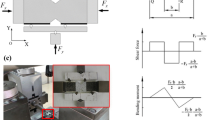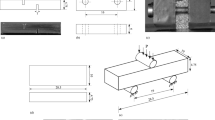Abstract
Material strength under complex stress states is vital for structure design. This paper studied the strength and failure behaviour of 3D C/C composites under compression-shear coupled loads. Experiments were conducted using a modified anti-symmetric four-point bending (MAFPB) method and off-axis compression method. Two dominant failure modes were observed; 1) shear and 2) compression. Mode transitions under relatively low shear/compressive rations were also observed. Results show that the material exhibits significantly lower failure stress under shear-compressive load compared to compressive or shear strengths alone. Further analysis revealed that meso-scale geometry characteristic including tow crimps and interfacial cracks are the main inducements: (1) tow crimps lead to local bending moment and increase local shear stress, (2) matrix-tow cracks formed under shear load degrade the lateral support of axial tows, (3) matrix fibre splitting and local buckling within tows induced by compressive load further reduce the shear strength of axial tows. Failure stresses in off-axis tests are lower compared to those in MAFPB tests due to the existence of bi-axial compression. These findings show that shear failure is a weakness for the 3D C/C composite and can provide insights for further material design and structural strength analysis.









Similar content being viewed by others
Data Availability
The raw/processed data required to reproduce these findings cannot be shared at this time due to legal or ethical reasons.
References
Xue LZ, Li KZ, Jia Y, Zhang SY, Ren JJ, You ZY (2016) Effects of hypervelocity impact on ablation behaviour of SiC coated C/C composites. Mater Des 108:151–156
Meng S, Zhou Y, Xie W, Yi F, Du S (2016) Multiphysics coupled fluid/thermal/ablation simulation of carbon/carbon composites. J Spacecr Rocket, 930–935
Guo H, Jia P, Wang B, Yang C, Li J (2016) Characterisation and analysis of the damage coupling effects of a 2D-C/SiC composite under proportional loading conditions. Ceram Int 42(1):1007–1014
Xie J, Fang G, Chen Z, Liang J (2017) An anisotropic elastoplastic damage constitutive model for 3D needled C/C-SiC composites. Compos Struct 176:164–177
Li DS, Zhao CQ, Ge TQ, Jiang L, Huang CJ, Jiang N (2014) Experimental investigation on the compression properties and failure mechanism of 3D braided composites at room and liquid nitrogen temperature. Compos Part B 56:647–659
Kuo WS, Ko TH, Lo TS (2002) Failure behaviour of three-axis woven carbon/carbon composites under compressive and transverse shear loads. Compos Sci Technol 62(7–8):989–999
Hatta H, Goto K, Aoki T (2005) Strengths of C/C composites under tensile, shear, and compressive loading: Role of interfacial shear strength. Compos Sci Technol 65(15-16):2550–2562
Xie WH, Peng ZJ, Meng SH, Xu CH, Yi FJ, Du SY (2016) GWFMM model for bi-modulus orthotropic materials: application to mechanical analysis of 4D-C/C composites. Compos Struct 150:132–138
Xu C, Han X, Cheng G, Meng S, Jin H (2018) Experimental study of ultra-high temperature interlaminar tensile strengths of 3D-needled C/C composites using the V-shaped notched specimen compression method. Mech Mater 126:26–35
Chen Z, Fang G, Xie J, Liang J (2016) Experimental study of high-temperature tensile mechanical properties of 3D needled C/C–SiC composites. Mater Sci Eng A 654:271–277
Xi YANG, Li HJ, Yu KH, Zhang SY (2013) Effect of stress level on fatigue behaviour of 2D C/C composites. Trans Nonferrous Metals Soc China 23(7):2135–2140
Xu C, Song L, Zhu H, Meng S, Xie W, Jin H (2018) Experimental investigation on the mechanical behaviour of 3D carbon/carbon composites under biaxial compression. Compos Struct 188:7–14
Lomov SV, Ivanov DS, Verpoest I, Zako M, Kurashiki T, Nakai H, Hirosawa S (2007) Meso-FE modelling of textile composites: road map, data flow and algorithms. Compos Sci Technol 67(9):1870–1891
Xie J, Fang G, Chen Z, Liang J (2018) Numerical and experimental studies on scattered mechanical properties for 3D needled C/C-SiC composites. Compos Struct 192:545–554
Jia Y, Liao D, Cui H, Ji A, Bai X, Yasir M (2016) Modelling the needling effect on the stress concentrations of laminated C/C composites. Mater Des 104:19–26
Cox BN, Bale HA, Begley M, Blacklock M, Do BC, Fast T et al (2014) Stochastic virtual tests for high-temperature ceramic matrix composites. Annu Rev Mater Res 44:479–529
O’Brien TK, Krueger R (2006) Influence of compression and shear on the strength of composite laminates with z-pinned reinforcement. Appl Compos Mater 13(3):173–189
Vogler TJ, Hsu SY, Kyriakides S (2000) Composite failure under combined compression and shear. Int J Solids Struct 37(12):1765–1791
Tian Z, Yan Y, Li J, Hong Y, Guo F (2018) Progressive damage and failure analysis of three-dimensional braided composites subjected to biaxial tension and compression. Compos Struct 185:496–507
Qiao Y, Bisagni C, Bai Y (2017) Experimental investigation and numerical simulation of unidirectional carbon fiber composite under multi-axial loadings. Compos Part B 124:190–206
Cichosz J, Wehrkamp-Richter T, Koerber H, Hinterhölzl R, Camanho PP (2016) Failure and damage characterization of (±30°) biaxial braided composites under multiaxial stress states. Compos A: Appl Sci Manuf 90:748–759
Rashidi A, Milani AS (2018) A multi-step biaxial bias extension test for wrinkling/de-wrinkling characterization of woven fabrics: towards optimum forming design guidelines. Mater Des 146:273–285
Ashab ASM, Ruan D, Lu G, Wong YC (2016) Quasi-static and dynamic experiments of aluminum honeycombs under combined compression-shear loading. Mater Des 97:183–194
Correa E, Barroso A, Pérez MD, París F (2017) Design for a cruciform coupon used for tensile biaxial transverse tests on composite materials. Compos Sci Technol 145:138–148
Xu CH, Han XX, Song LY, Meng SH, Xie WH, Jin H (2018) A modified anti-symmetric four-point bending method for testing C/C composites under biaxial shear and compression. Exp Mech 58(3):515–525
Budiansky B, Fleck NA (1993) Compressive failure of fibre composites. J Mech Phys Solids 41(1):183–211
Yang C, Jiao G, Guo H (2014) Failure criteria for C/SiC composites under plane stress state. Theor Appl Mech Lett 4(2):6–021007
Koerber H, Xavier J, Camanho PP, Essa YE, de la Escalera FM (2015) High strain rate behaviour of 5-harness-satin weave fabric carbon–epoxy composite under compression and combined compression–shear loading. Int J Solids Struct 54:172–182
Jones RM (2014) Mechanics of composite materials. CRC press
Acknowledgements
This research is sponsored by the National Natural Science Foundation of China (11472092, 11672088, and 11502058), and the National Basic Research Program of China (2015CB655200). The authors are grateful for this financial support.
Author information
Authors and Affiliations
Corresponding author
Additional information
Publisher’s Note
Springer Nature remains neutral with regard to jurisdictional claims in published maps and institutional affiliations.
Rights and permissions
About this article
Cite this article
Xu, C., Yang, Q., Jin, H. et al. The Failure Mechanism of 3D C/C Composite Under Compression-Shear Coupled Loads: An Experimental Study. Exp Tech 44, 275–282 (2020). https://doi.org/10.1007/s40799-019-00351-x
Received:
Accepted:
Published:
Issue Date:
DOI: https://doi.org/10.1007/s40799-019-00351-x




